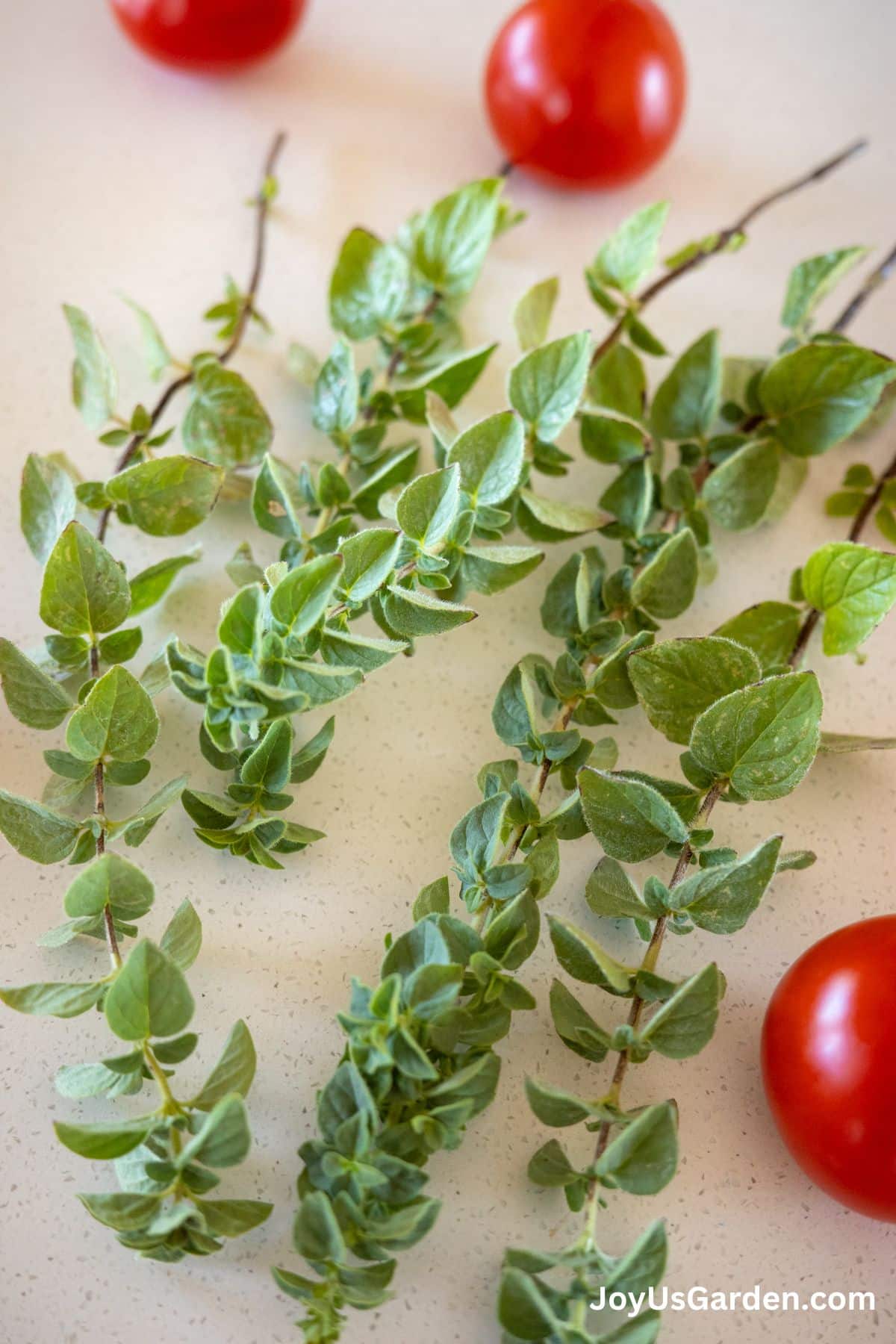With their aromatic leaves, small measurement, and low upkeep wants, culinary herbs are a number of the finest companion crops for flowers and greens. Not solely do herb companion crops repel backyard pests and increase the expansion of neighboring veggies, however companion planting with herbs can also be helpful for suppressing weeds and attracting useful bugs. Plus, herbs are simple to slide into container gardens – a particular boon for city gardeners and anybody in search of methods to develop extra edible crops in a small house!
Discover ways to use herb companion planting to your benefit in a container or vegetable backyard, and uncover some wonderful companion plant pairings within the suggestions beneath.
Companion Vegetation For Herbs

What Is Companion Planting?
Natural gardeners have been utilizing companion planting for generations for pure pest management and different perks. The idea behind companion planting is straightforward: some backyard crops naturally complement one another’s progress, and planting these companions collectively makes gardens develop higher.
Many flower and vegetable crops can be utilized as plant companions, however herbs are particularly good candidates for companion planting since they provide quite a few advantages to their neighbors.
Advantages Of Companion Planting
The most typical motive gardeners use companion planting is for pest management. Some strongly scented crops naturally repel undesirable pests, like Japanese beetles, carrot root flies, white cabbage moths, and the bean beetle. Different crops entice predatory bugs, like hoverflies and ladybugs, that feed on plant pests.
Nonetheless, there are lots of advantages of companion planting past pest management, together with:
- Fewer weeds. Low-growing crops, like creeping thyme, are sometimes used as pure groundcovers to scale back weeds and lock in soil moisture ranges.
- Improved plant progress. Legumes, like beans and peas, naturally enhance soils and increase the expansion of different crops.
- Area financial savings. Tall crops, like corn, perform as pure trellises for vining beans, whereas small herbs will be planted on the base of taller crops to fill in empty house.
Companion Planting Fundamentals
When selecting companion crops, it’s all the time a good suggestion to analysis the rising wants of the crops you’d wish to develop. Though many herbs, flowers, and veggies will be planted collectively, crops with very completely different care wants received’t make nice plant companions within the backyard.
As an illustration, Mediterranean herbs love well-draining, sandy earth, in order that they aren’t good companion crops for veggies that crave moist soil!
For finest outcomes, choose crops with the identical primary mild and water wants and decide whether or not vining crops want trellising. As a common rule of thumb, mild feeding crops will be grown collectively, however heavy feeding crops, like tomatoes and potatoes, ought to be refrained from different heavy feeders.
You’ll additionally wish to analysis whether or not crops are annuals or perennials, as planting perennial herbs in a backyard mattress stuffed with annual greens could make tilling and mulching just a little difficult.
When you’ve settled on the sorts of crops you’re enthusiastic about rising, double-check that your backyard has sufficient house to accommodate your plant alternatives. Good airflow is important for wholesome plant progress and for stopping points like powdery mildew. Many herbs develop fantastically in small, 6” pots, however you have to extra space if you wish to develop a number of herb and vegetable crops collectively!
Fundamentals of Herb Gardening
Most herbs are full solar crops, which suggests they want at the least 6 to eight hours of vivid mild each day. Nonetheless, dill, cilantro and some different tender-stemmed herbs will develop higher in scorching climates with mild afternoon shade.
Tender-stemmed herbs want common watering, whereas herbs with woody stems, like lavender and oregano, favor to develop in well-drained soil with much less moisture. Usually, herbs are mild feeders that don’t want a lot fertilizer however can profit from a month-to-month dose of diluted, liquid natural fertilizer through the rising season.
For much more planting choices, most potted herbs will be grown indoors with a develop mild and harvested 12 months spherical!
Are you new to herb gardening? Our newbie’s information to herb gardening will probably be a useful resource for you.

Companion Vegetation For Fashionable Herbs
Basil
Basil is a flexible herb that companions nicely with most veggies and tender-stemmed herbs, but it surely’s a very good match for tomato crops! When planted with tomatoes, basil repels pests like tomato hornworms, whereas taller tomatoes return the favor by shielding basil leaves from sunburn.
Oregano
Since most pests keep away from oregano’s sturdy aroma, oregano is an efficient plant to develop for common pest safety. Oregano is particularly good for controlling cucumber beetles on melons, pumpkins, and different members of the Cucurbit plant household.
Thyme
Whereas thyme can be utilized for pest management, it’s additionally a improbable plant for weed prevention. Strive rising creeping thyme as a low upkeep groundcover or plant frequent thyme or lemon thyme close to Brassicas to repel cabbage worms!
Chives
Chives and different crops within the Allium household are well-known for his or her sturdy scent, which deters a variety of pests. Develop chives as border crops round your backyard to maintain deer and rabbits from searching in veggie beds, or pair chives with carrots to discourage carrot flies. When you preserve roses, plant chives close by to stop black spot.
Parsley
Parsley can be utilized as a companion plant for a lot of greens, but it surely’s typically paired with asparagus for asparagus beetle management. If you wish to use parsley to draw hoverflies and different useful bugs, let a few of your parsley crops flower!
Mint
Aphids, flea beetles, and cabbage loopers keep away from mint crops, making mint an awesome companion plant for tomatoes and Brassicas. However chances are you’ll wish to develop mint in its personal pot close to your backyard to maintain mints from rising aggressively.
Dill
Dill flowers entice useful bugs, like hoverflies and parasitic wasps. Preserve pests at bay by planting this annual herb close to Cucurbits, Brassicas, lettuce, and candy corn, and don’t pull up your dill crops once they begin to bolt!
Sage
Sage acts as a pure insect repellant for flea beetles, cabbage loopers, and carrot flies that concentrate on Brassicas and root veggies. Simply keep in mind to plant sage in a spot the place it received’t overshadow smaller crops — sage is a perennial that grows fairly giant.
Cilantro
Cilantro flowers are extremely enticing to predatory wasps that feed on pests like spider mites and cabbage loopers. Take full benefit of cilantro’s pest stopping properties by rising this herb close to crops that entice pest caterpillars, like tomatoes, spinach, and Brassicas.
Rosemary
Beans, Brussels sprouts, and different Brassicas all profit from rosemary’s skill to repel pests. Nonetheless, as a result of rosemary crops aren’t cold-hardy, chances are you’ll wish to develop this herb in a pot and produce it indoors within the winter.
Right here’s an inventory of companion crops for rosemary, in addition to a information to pruning oregano.
Frequent Errors & How To Keep away from Them
Though most herbs develop nicely with greens and different herbs, there are a couple of exceptions. Rising chives close to beans and peas can intervene with legumes’ nitrogen-fixing properties. Dill and carrots additionally don’t get alongside as these two crops are intently associated and entice the identical pests.
Apart from incompatibility points, it’s additionally necessary to keep in mind that woody-stemmed herbs can develop root rot in the event that they’re stored in overly moist soil. If you wish to develop these crops close to water-loving herbs and veggies, separating them into completely different pots or beds could also be sensible.
To keep away from points with overcrowding, all the time learn plant labels and seed bundle directions and observe the advisable spacing tips. Rising too many crops collectively in a small house can have an effect on their total well being and result in mildew points or stunted plant progress.
We’ve assembled a information with herb backyard necessities and the instruments to develop herbs.
Seasonal Suggestions & Upkeep
Harvesting herbs all through the rising season makes crops extra productive, however it’s also possible to prune crops in the event that they want reshaping. In the reduction of stems to a leaf node to encourage branching, however don’t lower woody-stemmed herbs again into their woody sections, and by no means take away greater than 1/3 of the plant’s leaves without delay.
Apart from pruning and harvesting, herbs should be watered often and will profit from fertilizer in spring and summer time. Chilly hardy perennial herbs will be left exterior through the winter, however mulching over the soil to guard their root methods is often sensible.
Warmth-loving herbs, like rosemary, will be grown as annuals or overwintered indoors in pots, whereas true annual herbs, like dill, must be planted yearly until crops are allowed to self-sow.
Quick on house? This information to rising herbs in raised beds will assist you to out.

Companion Planting For Herbs In Pots
Utilizing herbs as companion crops in container gardens is a brilliant technique to squeeze extra crops right into a small house. To not point out, you should use these tasty herb leaves so as to add taste to the greens you develop in your container backyard!
Ensure to maintain your potted crops in an space that receives at the least 6 to eight hours of vivid mild, and select an appropriately sized pot to suit the crops you’d wish to develop. Whereas a single basil plant can slot in a 6” container, if you wish to develop basil with tomatoes or one other vegetable plant, bigger 5 to 10-gallon develop luggage are often a greater possibility.
Guarantee that any container you utilize has drainage holes within the base, after which fill it up with well-draining soil meant for container gardens.
When you’d wish to develop herbs and greens collectively in a single pot, check out a few of these plant mixtures:
- Tomatoes with basil
- Bush cucumbers with dill
- Bush beans or bush peas with rosemary
Excited by rising your personal? Find out about rising herbs for a tea backyard, plus rising 22 herbs for cooking.
FAQ’s Companion Vegetation For Herbs
Sprawling crops like pumpkins rapidly drown out smaller herb crops. Nonetheless, you might be able to develop these spreading crops with herbs when you select small pumpkin varieties and prepare their vines to develop on trellises.
Woody-stemmed herbs and tender-stemmed herbs typically don’t combine within the backyard as they’ve completely different soil moisture wants.
Basil is likely one of the finest companions for tomatoes, however it’s also possible to strive companion planting herbs like chives, parsley, dill, and oregano close by for a bountiful harvest of tomatoes!
Conclusion
Fragrant herbs make supreme companions for different herbs, greens and flowers, however they may also be used to taste your homegrown veggies when harvest season arrives. For much more planting inspiration, take into account planning out a salad, salsa, or pizza backyard, full with all of the greens and herbs you get pleasure from utilizing in your recipes.
Preserve some oregano in your pizza backyard to enhance the style of the tomatoes you develop, or plant cilantro in your salsa backyard to boost these homegrown onions, peppers, and tomatoes. The appropriate companion crops not solely make gardens develop higher, however additionally they come in useful within the kitchen!
Comfortable gardening,
-Lauren
Lauren Landers is a Grasp Gardener and gardening author residing in Maine. After working a small natural farm in New England for a number of years, Lauren transitioned to freelance writing and loves serving to others uncover the great thing about natural and pollinator gardening!
This put up could comprise affiliate hyperlinks, you’ll be able to learn our insurance policies right here.



